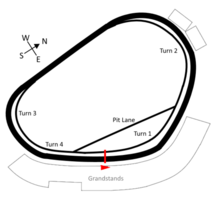Nazareth Speedway
|
|
|
|
|
|
||
| Route type: | permanent race track | |
|---|---|---|
| Owner: | International Speedway Corporation | |
| Operator: | International Speedway Corporation | |
| Opening: | 1966 | |
| Decommissioned: | 2004 | |
| Speedway oval | ||
| Route data | ||
| Important events: |
CART / Indy Racing League Firestone Indy 225 (1987-2004) NASCAR Busch Series NASCAR Craftsman Truck Series |
|
| Route length: | 1.522 km (0.95 mi ) | |
| Curve superelevation: | Curve 1 & straight line: 2.7 ° Curve 2 & 3: 3 ° Curve 4 & 5: 4 ° |
|
Coordinates: 40 ° 43 ′ 42 ″ N , 75 ° 19 ′ 15 ″ W.
The Nazareth Speedway was a speedway in Lehigh Valley , Pennsylvania with a length of 0.946 miles (1.522 km). Most recently races of the NASCAR Busch Series and Craftsman Truck Series as well as the IndyCar Series were held on it.
history
While motorsport events were held on the speedway as early as the 1910s, the history of the modern Nazareth Speedway began in 1966 when it was renovated and reopened in April 1966 as a speedway with five curves and a length of 1.126 miles. At that time it was a pure dirt track on loose ground, on which races of the Whelen Modified Tour were held. At the first and only event in 1966, Frankie Schneider achieved the fastest qualifying time, won his prelim and also the main race.
A total of nine races were held in 1967, more than in any other year. Schneider won five of these nine races. In the following year Schneider won three of the five events. On July 13, 1968, the first race of the USAC National Championship took place at Nazareth Speedway, which Al Unser won in front of local hero Mario Andretti .
Between October 15, 1966 and its closure on November 7, 1971, a total of 52 races were held on the speedway. The most successful driver was Frankie Schneider, who won a total of eleven races.
In 1982 Lindy Vicari took over the circuit and shortened it to a length of one mile. After only two years the speedway was closed again and bought by Roger Penske in 1986 . It was then renovated and paved. In 1987 it reopened as the Pennsylvania International Raceway . At the time, it was the first oval race track to have an extra warm-up lane for entering and exiting the pit lane . The curve superelevation was between 2.7 ° and 6 °, the back straight was 1200 feet (approx. 366 m) and the start-finish straight 800 feet (approx. 244 m) long. Further renovations took place in 1997 when the outer wall and safety fences were renewed and new stands were built.
A special feature of this tri-oval is its asymmetrical design. The kink that represents the first curve is not exactly in the middle, so the start and finish straight is slightly longer than the straight between curve 1 and 2. The only two comparable routes are Phoenix International Raceway and Walt Disney World Speedway .
Simultaneously with the reopening, the Nazareth Speedway was added to the racing calendar of the NASCAR Busch Series , which held races here until it closed in 2004. From 1997 the Craftsman Truck Series was also hosted here, which held races on the track until 2001.
In 1999 the International Speedway Corporation (ISC) bought the Nazareth Speedway. Although the Busch Series and IndyCar Series races were relatively successful, the speedway was closed at the end of the 2004 season. The races have been replaced by events at Watkins Glen and other ISC circuits. The speedway has been for sale since then and has been largely dismantled. The grandstands, which were only renewed in 1997, were rebuilt in Watkins Glen.
Route length
It reopened in 1987 as a slightly reconfigured one-mile oval. Although architects and contestants knew the lap length was less than a mile, the CART's official timekeeping used a length of one mile. This led to the fact that the official fuel consumption over a racing distance was calculated higher than it actually was. As a result, teams could sometimes get by with a refueling stop and thus gain an advantage. It was not until 1997 that the official length was corrected to 0.946 miles (approx. 1.52 km). Accordingly, the race length has been corrected from 200 laps (200 miles) to 225 laps (212.85 miles). In the races of the Indy Racing League from 2002 to 2004, a track length of 0.935 miles (1.504 km) was used for timekeeping. The guidelines and methods used to determine this route length are not specified.

